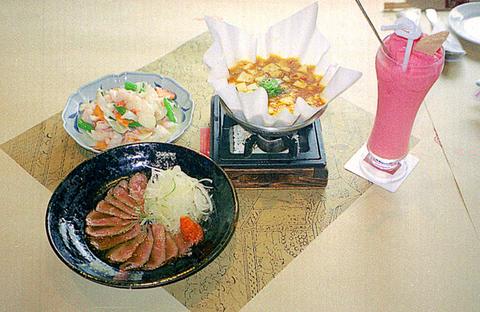The term "modern Chinese cuisine" might not mean much to those who haven't sampled the fare at Taipei's People restaurant (人間), but for the thousands who have frequented the dimly lit yet fashionably chic joint, then the term conjures up images of plates of food that boast a fusion of colors and the truly tantalizing taste explosions that accompany the restaurant's fantastic cuisine.
According to People's manager, Daphne Hua (華昌德), the secret of the joint's continued success lays with People's chefs' ability to blend modern ideas with age-old recipes. Open to the adaptation of simple home-style Chinese cooking, the origins of every dish on the menu lay with those that have been knocked out in kitchens across China for generations.
Not that diners would ever guess that the food they are munching on is of the same ilk as that cooked in homes nationwide. The combination of colors ensures that every dish fashioned in the kitchens of the People restaurant appears almost good enough to frame and hang on the wall. And with no MSG or artificial flavorings added to any of the food the taste remains as pure as nature intended.

PHOTO: GAVIN PHIPPS, TAIPEI TIMES
Keeping the foodstuffs' original taste certainly doesn't make for blandness, however, as People's combination of ingredients means that even the simplest of dishes is a sheer pleasure. Along with the appearance and taste, a meal at the People's won't break the bank or empty your wallet.
Moderately priced and too numerous to list in full, some of the restaurants' most popular dishes include deep-fried chicken slices with lime sauce (檸檬雞片) (NT$300), stir-fried sirloin slices on a pottery plate (陶盤牛肉) (NT$320), simmered sea-bass belly with soy sauce (燜燒魚肚膛) (NT$360), spicy bean curd in a paper pot (人間豆腐) (NT$250) and the interestingly named Buddha's meal (羅漢齋) (NT$280).
Along with a fine selection of savory dishes, the menu also includes an extensive drink list, with the wide selection of cocktails, liquors, beers, teas, coffees and soft drinks all as moderately priced as the food.
While the menu currently lists upwards of 120 dishes, in one month this is set to be cut back to 80. The reason behind People's decision has nothing to do with the seemingly never-ending economic downturn, however. Restaurant management has instead decided to cut the number of dishes on offer in order that the quality of the most popular cuisine can be refined and, if in deed possible, improved upon.

The 1990s were a turbulent time for the Chinese Nationalist Party’s (KMT) patronage factions. For a look at how they formed, check out the March 2 “Deep Dives.” In the boom years of the 1980s and 1990s the factions amassed fortunes from corruption, access to the levers of local government and prime access to property. They also moved into industries like construction and the gravel business, devastating river ecosystems while the governments they controlled looked the other way. By this period, the factions had largely carved out geographical feifdoms in the local jurisdictions the national KMT restrained them to. For example,

The remains of this Japanese-era trail designed to protect the camphor industry make for a scenic day-hike, a fascinating overnight hike or a challenging multi-day adventure Maolin District (茂林) in Kaohsiung is well known for beautiful roadside scenery, waterfalls, the annual butterfly migration and indigenous culture. A lesser known but worthwhile destination here lies along the very top of the valley: the Liugui Security Path (六龜警備道). This relic of the Japanese era once isolated the Maolin valley from the outside world but now serves to draw tourists in. The path originally ran for about 50km, but not all of this trail is still easily walkable. The nicest section for a simple day hike is the heavily trafficked southern section above Maolin and Wanshan (萬山) villages. Remains of

With over 100 works on display, this is Louise Bourgeois’ first solo show in Taiwan. Visitors are invited to traverse her world of love and hate, vengeance and acceptance, trauma and reconciliation. Dominating the entrance, the nine-foot-tall Crouching Spider (2003) greets visitors. The creature looms behind the glass facade, symbolic protector and gatekeeper to the intimate journey ahead. Bourgeois, best known for her giant spider sculptures, is one of the most influential artist of the twentieth century. Blending vulnerability and defiance through themes of sexuality, trauma and identity, her work reshaped the landscape of contemporary art with fearless honesty. “People are influenced by

Ten years ago, English National Ballet (ENB) premiered Akram Khan’s reimagining of Giselle. It quickly became recognized as a 21st-century masterpiece. Next month, local audiences get their chance to experience it when the company embark on a three-week tour of Taiwan. Former ENB artistic director Tamara Rojo, who commissioned the ballet, believes firmly that if ballet is to remain alive, works have to be revisited and made relevant to audiences of today. Even so, Khan was a bold choice of choreographer. While one of Britain’s foremost choreographers, he had never previously tackled a reimagining of a classical ballet, so Giselle was